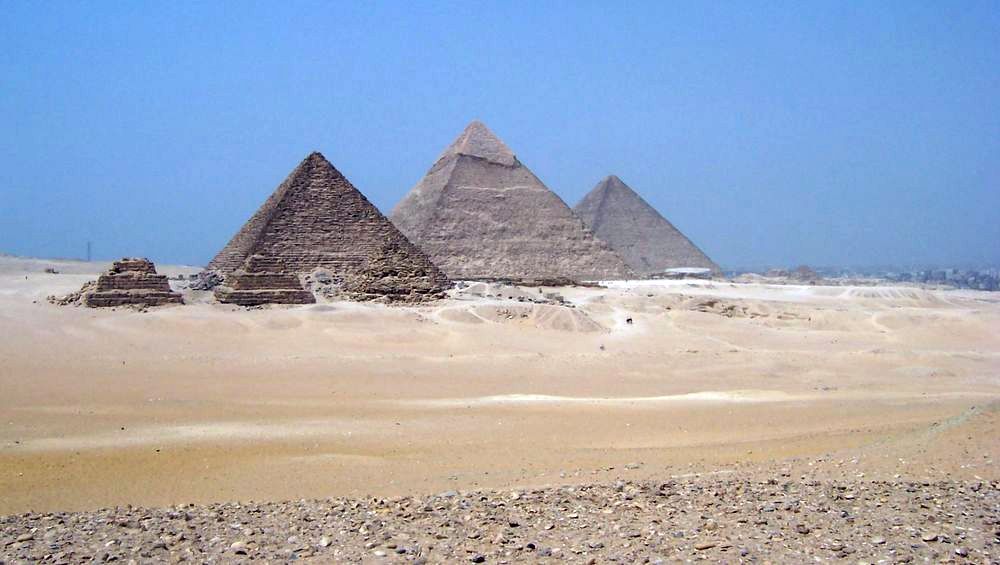How did the Egyptians build the pyramids? This is the big question we ask ourselves when we talk about this emblematic site of ancient Egypt. The answer is not obvious because today we still do not know how they were made. But fortunately, we have some assumptions, of course.
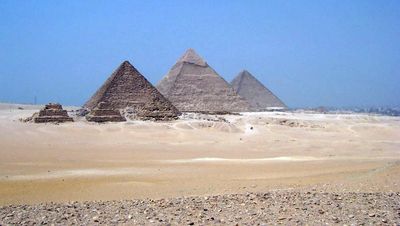
The Pyramids of the Giza Plateau
Overview
When we talk about the construction of the pyramids of Egypt, we are quickly confronted with several subjects of study. It is indeed necessary to evoke the site of implantation, the size of the pyramid to be constructed as well as the complexity of the various buildings which accompany it, the organization of the works, the management of the workers, the size of the stones, their provenances, their equipment, etc. We must also deal with technical constraints, time management, raising stones, transportation, etc.
Of course, here we will focus on the most important points.
Funeral complex
First of all, you should know that a pyramid in itself is not a useful building. It only makes sense if it is part of an important funeral complex comprising various compulsory or optional buildings, depending on the time. Because of course, over the 1000 years that lasted the construction period, they have evolved. By necessarily a lot, but they have evolved. So what was a royal funeral complex?
It was a rectangular area protected by a high wall, the enclosure. Inside, the pyramid is the most important building, but the latter is accompanied by a high temple connected to a low temple, outside the enclosure, by a pavement (often covered). The ensemble is completed by warehousing shops, for example for the offerings, pyramids annexes serving as the tomb of the queens or being simple pyramids of worship. Plus a whole lot of other annex buildings, depending on the will of Pharaoh. The lower temple served as an embalming room, the mummified body was transported through the high road to the temple high where were performed daily rites of celebration, before being placed in the sarcophagus, in the galleries under the pyramid.
Choice of location
The location of a funeral complex was paramount: From this choice flowed the success of the project, but there were so many spiritual and technical constraints that it was not easy to choose the right place.
First, there were spiritual constraints. In the Egyptian imagination the Nile divided the territory in two. The eastern part is that of the rising sun, it belongs to the living. Those of the West are those of the setting sun, they are on the side of the dead. The necropolises must therefore be on the left side of the Nile. It was also necessary that they be in full sun, from the moment when the cult of Ra progressed in spirituality, that is to say at the beginning of the era of the pyramids. We already imagine the sector: desert, flat. But it was not the only spiritual constraint, since it was also necessary that the tombs are close to the capital Memphis, so that the pharaoh, once deceased, is close to his people.
This last spiritual constraint is related to an important technical constraint: The capacity of the site to accommodate a large number of workers. So you had to be close to a big city, or at least a more or less urbanized area. Note that during the construction of the pyramids of Khufu and Khafra, a working-class city was deliberately built to house the workers, but also to accommodate all that was necessary for their daily lives. We do not have any traces of such a city in Saqqara.
Among the other technical constraints, one of the most important was the nature of the soil that had to be strong enough to receive the monument. (See below). The area should also be very large (the funeral complexes could measure up to 600m long and 400m wide), and have the opportunity to orient the pyramid as desired.
Finally, it was necessary that the site is close to the Nile to allow the easy transport of building materials, but not too close to avoid the floods of the Nile. For that, we choose sites in height, on trays.
To meet so many criteria there were not too many solutions. The rocky plateaus of Saqqara and Giza were ideal candidates, hence the presence of the pyramids there.
Learn more about the location of the pyramids.
Constraints on the ground
How much weighs the great pyramid of Khufu, the largest of all?
Five million tonnes, the weight of 500 Eiffel Tower! Such a figure is impressive, and one can legitimately ask if the ground that must host it is strong enough for that. This is a crucial question because otherwise the pyramid would never rise.
The choice of the site is therefore always on calcareous soils. It is not the hardest stone, but it is almost the only one, with the will (much more fragile) that is usable, the rest of the ground was, at the time, only sand or sand. friable earth.
In Giza, the necropolis was built on a plateau overlooking the Nile Valley. In Saqqara, it's the same thing, on a much bigger plateau. Same for Dahshur or Abusir, north and south of Saqqara. The ancient Egyptians still built on limestone plateaux near the Nile. And incidentally, on the left bank, the west, because it represented the side of death (it is on this side that the Sun sets), unlike the East side, that of the living (where the Sun is survey). But these spiritual considerations have nothing to do with architecture ...
Materials choice
The materials used are of several kinds:
- Limestone
- Granite
- syenite
- The sandstone
- The wood
- Raw brick
These materials did not serve the same purpose, of course. If limestone is the one that has been most widely used, especially to make the massive pyramids oldest, the raw brick replaced it during the Middle Kingdom, a few centuries later. It must be said that these late pyramids were much smaller, so they could bear the load of the massif without collapsing, which could not have been done for the monumental pyramids whose weight would have crushed the bricks, causing the building to collapse on himself.
And since a pyramid is only one element of a more complete funerary complex, the ancient Egyptians used other materials to build the ancillary buildings. Wood was used in some cases for these ancillary buildings, for example.
Learn more about the building materials of the pyramids.
Transportation of materials
The transport of stones is essentially only for distant quarries. Roughly speaking, all the pyramid sites are in the northern part of the country, just before the Nile delta. However, the basic limestone was extracted directly from the site or nearby. The question of transport is therefore no more than that of raising stones.
On the other hand, for the stones of Tourah, it was necessary to move them from the quarry to the building sites. If the distance was not so high - only a few dozen kilometers, at most - a means of transport was necessary. A priori, for Tourah, it is the land transport was chosen, because to pass by the river would not have been of a great help, considering the geographical position of the pyramids compared to the quarry.
River transport
On the other hand, it is the river transport that was used for all the stones coming from the distant quarries, like the granite of Aswan. They were landed from a special port, usually the lower temple of the pyramid, before going up the pavement to the site of the high temple and the pyramid.
The question then arises, how were blocks loaded onto the boats? Indeed, they are so heavy that it is unthinkable that they could be raised up to the deck of ships. In fact, the answer is as simple as it is beautiful. The Egyptians had invented special boats, broad and with low edges. During the summer they dug pits on the banks and installed these boats whose edges reached the ground level. Then they just pulled the blocks over and waited for the flood of the Nile, which floated the ships.
There was then only to haul them to the destination, which must have been a particularly painful job ... Sometimes, when conditions allowed, the boats were pulled by other boats with a other traction system, for example by wind.
To get from Aswan, where the granite quarries were, to Memphis it took hardly a week of navigation, when the Nile was in flood. It was then a period of intense navigation, with all the boats making the most of round-trip during this rather short period.
The sleds
It should be known that for land transport, the ancient Egyptians did not use the wheel. They used large wooden sledges that they slid on the ground or, most often, on logs. They were drawn by groups of unskilled employees whose only job was this forced labor. The number of people depended on the load to be fired. To get an idea, a fresco of the middle empire shows us 4 rows of 43 men, a total of 172, to draw a statue that is estimated at 60 tons. Sometimes Egyptians used animals (oxen / horses) but it was rare.
To minimize friction on the floor, the sled was poured in front of the sled.
Block size
The heavy blocks of stone that constitute the pyramids of the 4th and 5th dynasty come from quarries of limestone near the sites. The pyramids of the VIth Dynasty were rather in raw bricks covered with fine limestone blocks of the quarries of Tourah.
These blocks had various sizes of course, depending on their future locations. There was no rule that they were pruned before or after the transport: In fact, it depended on the yards and their organizations. Some sites required that the blocks arrive already trimmed, or at the limit just roughly cut, but others required that the size is made on the spot. Anyway, often the quarry was close to the site, which solved the problem ... This was the case on the site of the pyramid of Khufu for example, the quarry is still perfectly visible on the spot, in the immediate vicinity of funeral complex. From a general point of view, the west bank of the Nile, from Memphis to Thebes, is almost all limestone cliffs to extract the building blocks.
The size of the blocks could be precise, very precise even, but again all the pyramids did not reach the same degree of perfection. On the pyramid of Menkaoure there could be adjustments to within a few centimeters, while some layers of the pyramid of Khufu were adjusted to the minimum! This state of affairs is surprising when we know the instruments used.
The tools
The tools are particularly rudimentary, they come straight from the Neolithic. They are hard stone instruments used to work granite and limestone. We used:
- Masses
- Chisels
- Hammers
For the measurements, the adjustments, the work of precision, one used levels, rules and squares as well as ropes, to measure the great distances. The Egyptians of the old empire knew only one metal: Copper. They had very few metal tools, mainly scissors, to cut the surface of the stones with precision, the saw without tooth and the drill. The toothless saw is a kind of metal blade that was used with an abrasive, to use the stone little by little.
Construction site organization
We imagine that each site was managed in a relatively similar way, from one site to another. Only the passing of time and the means of Pharaoh could change the organization.
The sites were organized around a hierarchical structure almost military. The pharaoh, the main interested, gave his orders to senior officials who transmitted them to the architects in charge of the site. They passed them on to the site managers and then to the foremen who did the work. Of course, each hierarchical level could take its own initiatives, in view of its possibilities.
The workers, at the bottom end of the scale, accounted for a quarter of the skilled craftsmen and for three-quarters of the local peasants who were employed when the Nile floods prevented work in the fields. The craftsmen had the tasks requiring some know-how, such as the size of the stone blocks, the leveling of the ground or the construction of construction equipment. Unskilled workers were used to forcing tasks, handling blocks and pulling them to their places.
All the workers were organized in teams of 2,000 people for a total of 20,000 employees on the site of the pyramid of Khufu. This figure is of course an estimate, but it is considered acceptable given the duration of the work and the work to be done. Teams of 2,000 employees were divided into two groups of 1,000, each group divided into phylons of 200, each grouped in groups of 20. These twenty employees were the base unit of the site group.
Elevation of stones
In practice, how could architects mount such a high pyramid with very small means compared to today? This question is central when we speak of the pyramid of Khufu, but also of the other pyramids of Egypt.
So let's say it immediately: We do not know how the ancient Egyptians built the pyramid of Khufu.
One can only assume, and make assumptions. Three stand out from the crowd: The technique of external ramps, that of the internal ramp, and that of silting.
a method of external ramps and that which holds the rope nowadays. It consists in believing that the ancient Egyptians climbed the stones on the superstructure floor by floor following a gently sloping ramp. Archeology has shown us that these types of ramps were indeed used, especially on the pyramid of Sesostris I (at the necropolis of Litch). In wood or raw stone, this ramp could have been built in different ways:
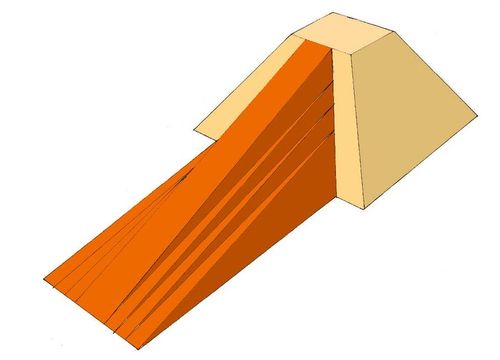
Front ramp
The frontal ramp is built on only one side of the pyramid. Of restricted width as the pyramid rises, it is also more and more steep, which complicates the task of the workers going up the blocks.
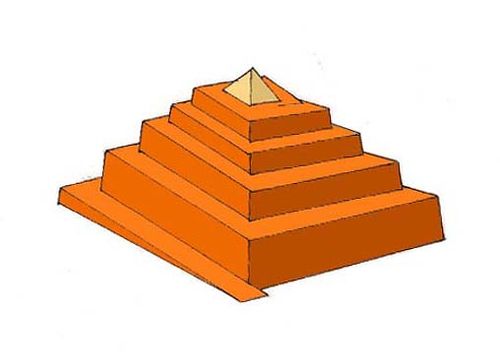
Wraparound ramp
The principle of the enveloping ramp is simple, it consists of having only one ramp that rotates at right angles to each stop of the pyramid. The higher you go, the longer the pyramid. Such a ramp is complex to implement, but it has the advantage of having a regular slope. On the other hand, it imposes the transport of loads over long distances.
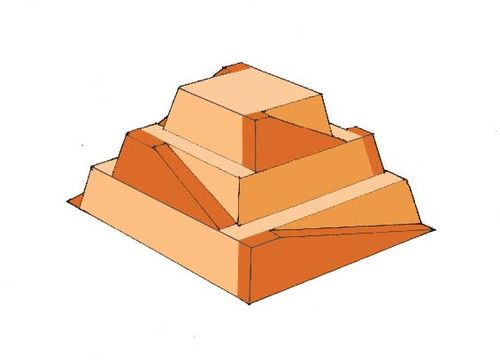
Side ramps
The side ramps are a succession of small ramps along the 4 sides of the pyramid to build. This type of ramp is easy to build and maintain.
Other types of ramps have been proposed, but it is a mixture of these three possibilities: The Egyptians of the time could have built the pyramids with two frontal ramps, one in use while the other is raised, the time that the workers finish the level and they can continue with the 2nd ramp, the first being at that moment also raised. Another attempt at explanation consists of a frontal ramp rising to a third of the height before continuing in the form of a helical ramp.
The method of the internal ramp is very original, it is recent. It is supported by the French archaeologist Jean-Pierre Houdin and consists of moving the blocks up an internal gallery. The latter would run behind each face a few meters, and climb gently to the floor under construction. If this hypothesis seems at first far-fetched, it is not only very serious but partly verified by the internal temperature records of the pyramid. These records reveal a temperature difference of the stones that follow an internal spiral path from bottom to top. It is therefore quite possible that a spiral gallery existed before it was filled.
The last method is that of silting. The idea is that once several stages are assembled, the main winds of the Giza plateau are expected to sow the work, which forms a natural ramp. This silting could also have been done artificially, by moving the sand on the side of the pyramid. The main problem of this technique is that it does not allow to make a pyramid as high as that of Khufu, sanding should have been done several hundred meters for that, which is unlikely.
Construction and equipment
The limestone blocks extracted from the quarries were coarse, just after their extractions. If they were destined for the structure of the pyramid, like most of them, they were roughly trimmed and reduced to the right size, but not excessively. It should be noted that the interstices between the large blocks were blocked with a mortar containing gypsum, sand and pieces of limestone.
The blocks were sent to the site and placed one above the other without much care, but the horizontality of each level was exemplary. Each stage of the pyramids was very precise, the platforms being systematically perfectly flat. The height of each row varied with the son of the progress of the works: The more one went up, the more the height of the blocks were weak. There is one exception to this rule, it is the pyramid of Khufu, which sees the height of its blocks decrease, then grow, then reduce, then grow, forming 18 cycles of variation of the heights of its blocks ranging from 50cm to 1m50 .
Inside the pyramid the blocks were paired without great care, with interstices sometimes wide of 10cm. The blocks could weigh several tons. The outside of the pyramid, ie the part that forms the faces, is made of smaller blocks, from 2 to 2.5 tons. These are much better cut, smoother and more regular, they are also better paired, with gaps much smaller and regular.
The cladding blocks, made of fine limestone, are even better cut, they represent the finish of the pyramid. The equipment is very precise and the shaving of each block is very precise.
When the pyramid is covered, on its lower part, with granite (as on the pyramid of Menkaure), the cutting of the blocks was done on the site of the building site, but their leveling done was once the stone placed. Thus, on the pyramid of Menkaure, granitic stones, perfectly leveled on one part, and not yet leveled on another, are still to be seen today. This is due to the fact that the yard was stopped before coming to an end.






